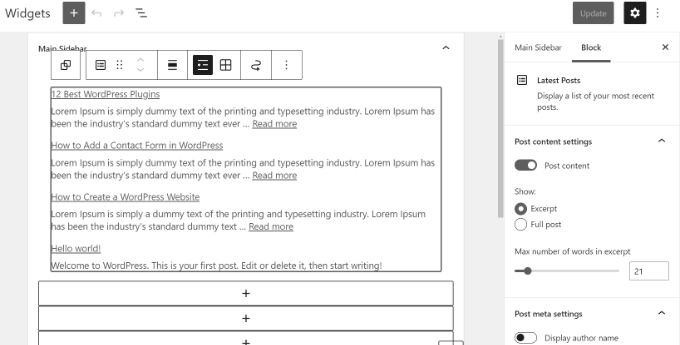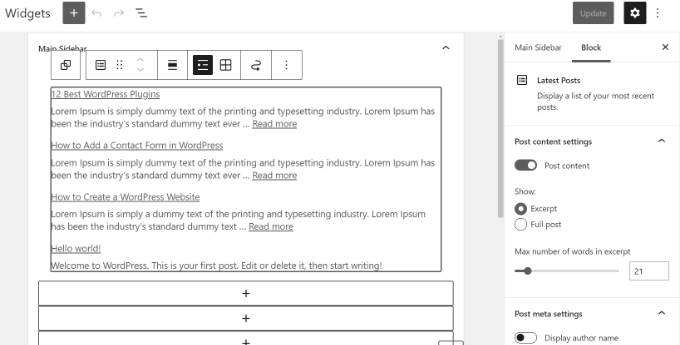The Latest Posts block should be visible throughout your site so that visitors can easily jump to your most recent content. You can place the block in a sidebar or after your main content. If you have questions about how to add this block to your website, you can visit the WordPress community and ask questions. I’m Will Morris, a WordCandy staff writer and stand-up comedian. You can read his articles on WordPress.com or on his blog, WordCandy.
Recent Posts Widget
You can easily customize the Recent Posts Widget on your site to display only specific categories or the latest posts. You can also use taxonomies and categories to filter the posts. You can also customize the layout of the Recent Posts Widget. If you’d like to customize its appearance, follow the steps below. You can change the default display settings by clicking the “Customize” button. Once you’ve done that, click “Save Changes.”
After you’ve made these customizations, you can now add the Recent Posts widget to any area of your site. You can add this widget to your sidebar or footer to display a list of recent posts. You can also use the widget to display featured images from other users’ posts. There are no coding skills required and it’s highly customizable. This widget can be added to any post or page and displays the publish date, author’s name, and number of recent posts.
Another great feature of this plugin is that it lets you customize the border type and the size of the thumbnails. This plugin is especially useful if you’re trying to display recent posts on your site. It also allows you to choose the default thumbnail size and color. You can also customize the layout of the recent posts widget to display them in other areas of your site. You can add it to your sidebar to display recent posts from your site.
To use the Recent Posts Widget, you must be a member of the WordPress community. To install the Recent Posts Widget, go to Appearance and click on Widgets. From there, you can drag and drop the widget into the sidebar area. Next, you should enter a title for the widget and set the number of posts you want to display. Finally, click the “Save” button.
Relevant plugin
Having a relevant list underneath your post content is a powerful way to increase traffic to your site. The Related Posts plugin is one such plugin. It automatically generates related post links based on context clues in your posts. Moreover, you can customize the relevant list to display specific categories and tags, as well as other related content. Related Posts can be displayed in various places on your website, including the sidebar and the widget areas.
Another popular plugin for displaying recent posts is the Relevant plugin. It offers users a number of widgets to display popular, related, or related posts. Its settings allow you to customize the look and size of the widgets. You can also customize the amount of popular posts displayed in the widget. Relevant is a free plugin, and the developers regularly add new translations. It is easy to install and uses a simple interface.
With this plugin, you can select which posts to display. This will enable you to choose the number of posts you want to display and resize the images. There are some limitations with this plugin, however, so it might not be a great option for large businesses. But the makers are constantly updating it, so you’re guaranteed to get the best version. The plugin has a premium version, so you can get it if you want more customization options.
Another popular plugin is Yet Another Related Posts Plugin. It provides you with multiple display options, including thumbnails, excerpts, and full posts. It is free to use and has SEO-friendly features. It also lets you customize the widget’s background colors. In addition to a customizable sidebar, Relevant allows you to choose which posts should be displayed. It is easy to use and is compatible with both the classic and Gutenberg block editors.
Jetpack’s Top Posts & Pages widget
Jetpack is a popular WordPress plugin that comes with a number of useful modules. Its Top Posts & Pages Widget is one of them. While the Jetpack feature set is basic, it is still useful, especially considering the plugin’s many other features. To learn more about Jetpack, read this article. This article will discuss how to install Jetpack and the benefits it offers.
First, let’s look at the functionality of this widget. Using the Jetpack stats module, you can see which posts are getting the most traffic. In addition to displaying popular posts, you can also exclude pages using the $page_ids_to_exclude_from parameter. The latter is ideal if you want to show only a single page’s most recent content.
Aside from the widget’s visibility settings, Jetpack also includes a Facebook Page feature. It displays posts from other Facebook users and even displays the cover photo. You can change its visibility and save configuration settings. This feature can expand your audience and provide viewers with a way to find the content on your website. With Jetpack, you can add social media links to your website, which will lead visitors to your site and give you even more traffic.
You can also add Google analytics and other useful modules to Jetpack. You can install Jetpack for free for all your sites. Premium Jetpack includes advanced features such as priority support and Google analytics. The widget also adds a contact form to your site. If you want to get more out of Jetpack, consider upgrading your site to the paid version. There are also many other bonus features included in Jetpack, including a blog feed and a contact form.

WP Latest Posts
The WP Latest Posts plugin automatically formats your blog’s posts, pages, and custom post types. This plugin also has advanced filtering options. With several options for each news block, you can customize your layout. WP Latest Posts supports custom CSS. Alternatively, you can choose to show all posts, or just a selection of posts. There are numerous configuration options for this plugin, including themes and widget styles. You can also add shortcodes or use Gutenberg blocks to insert your news.
While content is vital for running a successful WordPress blog, it’s not sufficient unless you use internal linking. The most effective way to link to related posts is by manually inserting relevant links in the content of your posts. Using a list of recent posts can help you build a solid internet linking structure. As a side benefit, you can also display a number of recent posts on your blog. Just be sure to add the necessary links manually so visitors can follow them.
If you’re looking for a new way to display your recent posts, WP Latest Posts will give you that. The app allows you to display recent posts from all categories, tagged posts, and custom post types, and is also responsive. The recent post list will display all recent posts on a single page or on every post. There are two ways to customize the widget, too: you can choose to show the recent posts in the sidebar or on the home page.
The popular WP Latest Posts plugin has many customizable settings, including displaying the post’s title, excerpt, and post date. You can also customize the layout of the widget by using the relevant shortcode. Using WP Latest Posts on a page or post will increase page views and improve the user’s experience. When visitors can easily find your latest posts, they’re more likely to stay on your website, which will increase your sales and traffic.
Native Gutenberg block
A recent post in Gutenberg’s native block displays automatically sourced blog posts. The block updates dynamically with new posts, and includes many options for layout. The blocks can be set to list or grid layouts, and inherit the default styling of the theme. The latest posts can be displayed on any dedicated website page. Gutenberg is a popular new editor for WordPress. This block will soon be rolled out to all sites using the platform.
When creating a block using Gutenberg, it’s important to understand how it works. It’s important to be familiar with React and modern JavaScript, as these are the languages for creating Gutenberg blocks. While JSX is a popular alternative, it’s best to use the ES5 syntax when writing your own blocks. Gutenberg uses an object called attributes to manage block properties. Creating a block in this way can give you more flexibility than just adding a widget to a page.
Once you have created a block in Gutenberg, you can edit it and publish it to your site. The editor allows you to select an image from the Media Library or drag it from a local folder. When you publish it, your images are automatically uploaded to the server. The latest posts will appear in the native Gutenberg block. It’s easy to navigate through Gutenberg’s code. But if you’re not comfortable with the block’s syntax, you can always turn off the new options for editing the block.
As Gutenberg is still in beta, you can customize its default styling. The block editor is also extensible, and third-party developers have created some very interesting blocks for Gutenberg. One thing to note is that it’s not a 1:1 substitute for page builders. It will take time for the full Gutenberg block editor to reach its full potential, but it’s on its way to becoming a more viable solution for standard content layouts.
Various onlinecourses have different delivery methods. Asynchronous courses, for example, tend to have a set schedule and deadlines for completing course work. Self-paced courses, however, are usually more flexible. Some asynchronous instructors release course materials week-by-week. These are more flexible than synchronous courses, but there are still some important differences. Learn more about asynchronous and synchronous courses by reading on! Listed below are the differences between the two types of onlinecourses.
Open online courses
Chinese higher education institutions have also joined the open education movement. Chinese universities have the resources to design open courses and work with international peers to incorporate open education into degree programs. In addition, as the open education movement gained momentum, more universities are making their own MOOCs available. As of September 2018, over 100 universities in China had made their own MOOCs available. Others are making other open educational resources available. In the coming years, more Chinese universities will join the open education movement.
FutureLearn is a massive open online course provider. It was founded by 12 universities in 2012 and offers 418 short courses in subjects ranging from digital product management to ecology, wildlife science, and globalization. Students can complete the courses to earn micro-credentials. The courses have an average length of 5 weeks, and some are longer than others. To learn more about each course, click on the blue enrollment links. These links take you to additional information about the course, and enrollment information.
The Johns Hopkins Bloomberg School of Public Health is dedicated to global discovery and education. As a part of this, the school offers on campus courses, online courses for academic credit, and self-guided OER opportunities. These resources are available at the JHSPH OCW website. A similar approach applies to MOOCs, which are courses that combine open online course resources and a university’s own content. This type of educational resource has the potential to change the way public health is taught.
Massive Open Online Courses are the new wave of learning that has swept the world. They allow anyone, regardless of income or educational background, to take courses online and earn a degree. These massive open online courses are often free of charge and offer an extensive educational experience. Open online courses are similar to traditional college courses with lectures, suggested reading, and forums. Unlike traditional college courses, they do not typically require papers, but rather encourage collaborative learning and network connections.

MOOCs
A MOOC is a massive open online course, which is an online course that is designed to be free for participation by anyone. The course is accessed through the Web, allowing anyone to attend regardless of their location, computer skills, or educational background. It’s a great way for people to learn something new or upgrade their skills. Read on to learn more. And, if you’re looking for an exciting new way to learn, check out MOOCs!
A MOOC can have supplementary reading material, videos, and quizzes. They also have a certificate and grade system. The best part about MOOCs is that they’re free. Students simply need to have access to the Internet, browse the course catalog, and watch the videos at their convenience. It’s similar to using Netflix, but it has some unexpected tangible benefits. This article will explore three of the most common benefits of MOOCs.
The lowest price: MOOC providers have an incentive to sell their course to as many people as possible. They must offer it at the lowest price possible to attract as many students as possible. This is a good thing for them, as the lower the price, the more students sign up. However, a MOOC’s production costs are relatively high, so it is a good idea to keep your prices low. After all, the more students sign up, the more profits a MOOC makes.
There is also the question of the future of elite institutions. While the technology may be beneficial for some, elite institutions often operate more like venture capital firms, offering subsidized education to highly-qualified students. The schools also strive to cultivate a sense of belonging and gratitude in their students. They then recoup their investment decades later in the form of donations from successful alumni. But the rise of MOOCs threatens this business model. While MOOCs are great for the elite few, it could damage the status quo.
The term “MOOC” is open to interpretation. Its precise definition is ill-defined. According to Wikipedia, a MOOC is an online course that offers unlimited participation on the web. Some MOOCs are free, while others require a fee. These online courses offer the full course experience for free to all those with an internet connection. It’s worth a look. You may be surprised at how popular MOOCs are!
Coursera
If you are interested in gaining new skills, consider taking online courses with Coursera. With over 1,600 courses to choose from, you can study everything from the science of data to strategic planning. In fact, 40% of the courses are related to activities, management, or the science of data. Some of the courses have more than a million students, and they offer content in many different languages. As a result, you can learn the latest in your native language, regardless of where you live.
To enroll in a course with a Coursera certificate, you must first sign up for an account. You can sign up through Google, Facebook, or Apple. In the latter case, you must enter your email address and full name. You should also create a password of at least 8 characters to protect your account. Once you have a Facebook account, you can also use Coursera’s platform to sign in. Once you have registered, you can start taking courses.
Coursera is an online learning platform. It is backed by top academic institutions and companies from many different fields. It was founded by computer science professors from Stanford University in 2012 and boasts more than 77 million registered users. The company has partnered with major companies, including IBM, Google, PwC, and MongoDB. If you’re looking for a job in a particular field, there are even courses that focus on it.
You can choose to audit Coursera online courses for free or pay to complete them. While auditing a course through Coursera is free, you will need to pay to receive the Certificate. You can choose to pay $29 or even more for the privilege of taking the certification exams. There are two options to sign up for a free course – the first is a free audit of a course or paying for one, and the second is to pay a fee of up to $399.
Although the courses at Coursera are not the same as those at a traditional university, they are not as slow as you might think. This means that you can complete a course faster and save a lot of time. Depending on how much time you want to spend on the classes, you can choose a pace that suits your lifestyle. You can also get a free certificate, which proves that you’ve done your homework.
Harvard Extension School
If you want to take a course at Harvard, but you don’t have time to attend the campus, you can take Harvard Extension School online courses. This program is open to all and offers classes for all levels. The school also offers certificate and degree programs on campus. To enroll, you will need to create an account, and sign up for classes. There are fall, spring, and summer semesters. You can also apply for graduate programs, but you must apply for at least two classes and earn certain grades in your previous classes.
The experience at Harvard Extension School is seamless across screen sizes. It focuses on the students, creating a narrative that maps the user’s journey. The site also has photos of students taking classes in corporate offices and at home. This helps people know exactly what to expect. Lastly, the course materials are easy to understand and follow. The videos are short and engaging, and you will find it easy to learn from them. The videos are designed to inspire you to enroll and take advantage of the course content.
In addition to traditional classes, Harvard Extension School offers online courses. Most courses are only three to five weeks long, but some are only four weeks long. Some students can complete their bachelor’s degree program in four on-campus classes, while others may be able to complete their program entirely online. In addition to online courses, Harvard also offers a variety of certificate programs. While most of these certificate courses are conducted at graduate level, others require a mandatory campus residency.
The history of the Harvard Extension School is a fascinating one. It was founded in 1835 by John Lowell Jr. and became a successful lecture series in Boston. One course attracted 10,000 students! After Lowell became president of Harvard University, he turned the lectures into a systematic adult education program. In 1909, the Board of Overseers approved the creation of a Department of University Extension. Then it became known as the Division of Continuing Education.








